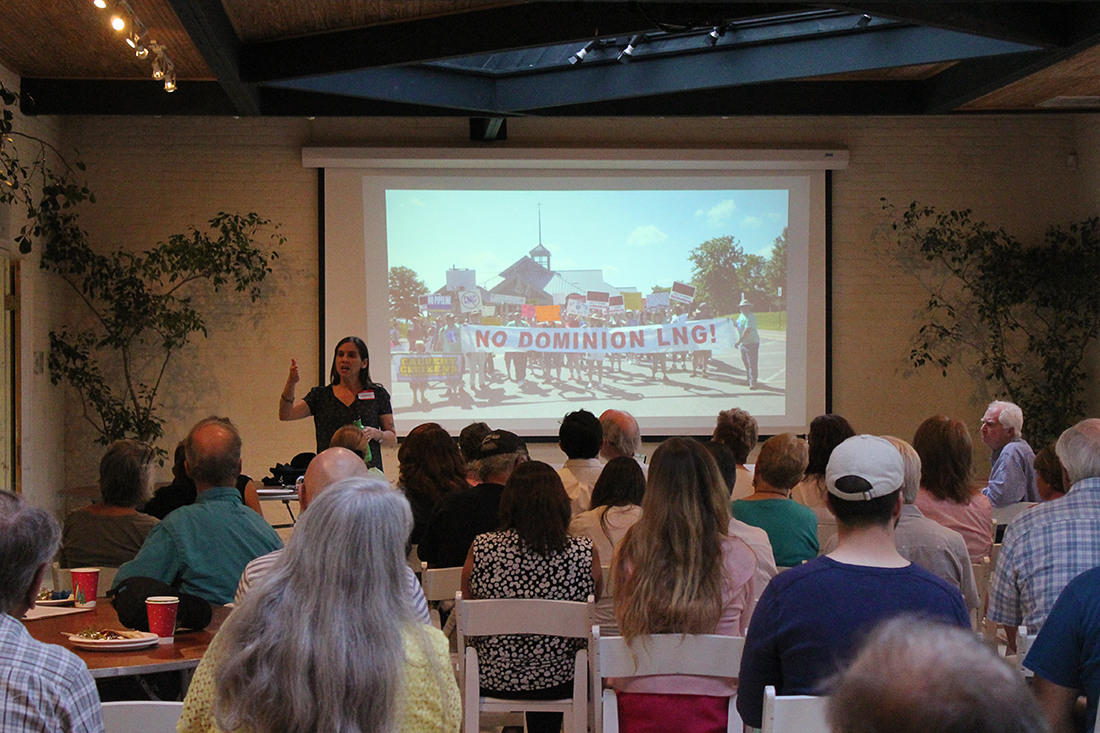
Stephanie Herweck, executive committee member of the Lower Rio Grande Valley Sierra Club, speaks about her visit to Lusby, Md. where residents voiced their concern over a liquefied natural gas terminal’s proximity to their town. Herweck presented to more than 60 attendees April 11 in the Alonso Building in downtown Brownsville. Felipe Zamorano/The Rider
Andrea Torres
THE RIDER
Stephanie Herweck believes a liquefied natural gas export terminal in the Port of Brownsville would bring problems to the neighborhoods near the proposed site.
“If anything were to happen there, there would be a lot of issues in terms of evacuation,” Herweck told a group of more than 60 people April 11 during the Save RGV from LNG meeting hosted at the historic Alonso Building in downtown Brownsville.
Texas LNG formally filed an application with the Federal Energy Regulatory Commission on March 31 to build the terminal in the port.
The company’s proposal is to construct two 2 million ton per annum liquefaction trains; two single containment, 210,000 cubic meter capacity storage tanks; one LNG carrier berth and dredge maneuvering basin; and all necessary ancillary and support facilities, according to a notice of application published last Thursday by FERC.
“These facilities will enable Texas LNG to liquefy and export up to 0.6 billion cubic feet of natural gas per day. Texas LNG states it will receive natural gas via a non-jurisdictional intrastate natural gas pipeline,” according to the notice.
Herweck, executive committee member of the Lower Rio Grande Valley Sierra Club, presented a map that showed the proximity of residential areas to the proposed Texas LNG site. She explained what could happen if there were an accident in the export terminal.
“In terms of safety, we are less than 2 miles from the Texas LNG site,” Herweck said. “That’s the 2-mile radius right there, so this is really putting Port Isabel in the evacuation zone–in the hazardous zone. … In addition, this is cutting off the evacuation route to [South Padre] Island.”
Annova LNG, Rio Grande LNG/Next Decade LNG and Texas LNG are among the companies that have proposed constructing export terminals in the Port of Brownsville.
The presentation was intended to inform residents of the area about what could happen if the LNG companies receive approval from FERC.
Part of Herweck’s presentation included pictures from her visit to Lusby, Md., where she met with residents who talked to her about their experiences with the construction of a Dominion LNG export terminal in Cove Point “A quote I have from a Lusby resident says, ‘If anyone were to do a risk assessment, Cove Point LNG would not be built,’” Herweck said. “But FERC is not requiring a risk assessment. FERC does not work.”
Dominion LNG applied for FERC approval of liquefaction and export in 2013. The following year, FERC approved the export terminal, Herweck said.
She said FERC approved construction of the export terminal in a densely populated area even though safety experts have identified the hazard zone to be within 3-mile radius of the export terminal.
Asked in an interview after the presentation why she believes FERC approved the Dominion project in Maryland, Herweck said FERC receives its budget from the fees companies pay in order to receive approval for permits.
“FERC isn’t working for us. It isn’t working for the people,” Herweck said. “Therefore, they are going to permit these projects, even though they don’t really pass muster in terms of safety, in terms of environmental impacts, in terms of health.”
Another member of the Sierra Club explained the process for approval to build an export terminal and for the public to intervene or comment on the proposal.
Individuals have the option to intervene in FERC proceedings and have the right to request rehearing of commission orders and seek relief of final agency actions in the U.S. Circuit Courts of Appeal, according to the commission’s website (ferc.gov).
Any motions to intervene, protests and comments may be filed electronically, with instructions given on the commission’s website under the “e-Filing” link, according to the notice.
Brownsville resident Oscar Zertuche attended the presentation because he wants to be more informed about the arrival of the LNG companies to the Valley.
“Get involved,” Zertuche said. “We are the ones that are going to be choosing who will be in the offices and who’s in charge of actually taking care of these situations. We are the ones that are getting to choose that. … It’s very important to speak out.”
To read the rest of the FERC notice, go to http://elibrary.ferc.gov/idmws/file_list.asp?document_id=14448523 and click on notice.DOCX.






